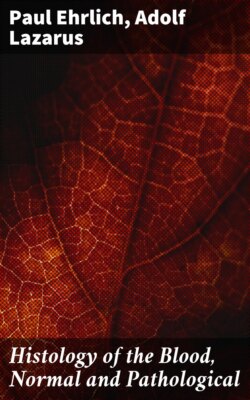Читать книгу Histology of the Blood, Normal and Pathological - Paul Ehrlich - Страница 14
На сайте Литреса книга снята с продажи.
1. Recognition of glycogen in blood.
ОглавлениеTable of Contents
This may be effected in two ways. The original procedure consisted in putting the preparation into a drop of thick cleared iodine-indiarubber solution under the microscope, as had been already recommended by Ehrlich for the recognition of glycogen.
The following method is still better. The preparation is placed in a closed vessel containing iodine crystals. Within a few minutes it takes on a dark brown colour, and is then mounted in a saturated lævulose solution, whose index of refraction is very high. To preserve these specimens they must be surrounded with some kind of cover-glass cement.
By the use of better methods the red blood corpuscles which have taken on the iodine stain stand out, without having undergone any morphological change. The white blood corpuscles are only slightly stained. All parts containing glycogen on the contrary, whether the glycogen be in the white blood corpuscles, or extracellular, are characterised by a beautiful mahogany brown colour. The second modification of this method is specially to be recommended on account of the strong clearing action of the lævulose syrup. In using the iodine-indiarubber solution a small quantity of glycogen in the cells may escape observation owing to the opaqueness of the indiarubber, and occasionally too by the separate staining of the same. The second more delicate method is for this reason recommended, in the investigation of cases of diabetes and other diseases[7].
2. The microscopic test of the distribution of alkali in the blood.
These methods rest on a procedure of Mylius for the estimation of the amount of alkali in glass. Iodine-eosine is a red compound easily soluble in water, which is not soluble in ether, chloroform, or toluol. But the free coloured acid, which is precipitated by acidifying solutions of the salt, is very sparingly soluble in water. It is, on the contrary, very easily soluble in organic solvents, so that by shaking, it completely passes over into an etherial solution, which becomes yellow. If this solution be allowed to fall on glass, on which deposits of alkali have been formed by decomposition, they stand out in a fine red colour as the result of the production of the deeply coloured salt.
In its application to the blood, of course the vessels used for staining as well as the cover-glasses must be cleaned from all adhering traces of alkali by means of acids. The dry specimen is thrown directly after its preparation into a glass vessel containing a chloroform or chloroform-toluol solution of free iodine-eosine. In a short time it becomes dark red. It is then quickly transferred to another vessel containing pure chloroform, which is once more changed, and the preparation still wet from the chloroform is then mounted in canada balsam. In such preparations the morphological elements have preserved their shape completely. The plasma shews a distinct red colour, whilst the red corpuscles have taken up no colour. The protoplasm of the white corpuscles is red, the nuclei appear as spaces, because unstained (negative nuclear staining). The disintegrated corpuscles and the fibrin which is produced, shew an intense red stain. These stains are peculiarly instructive, and shew many details which are not visible in other methods. The study of these preparations is really of the highest value, since they allow the products of manipulation of the dry preparation and every error of production to stand out in the most reliable manner, and so render possible a kind of automatic control. The scientific value of this method lies in the fact that it throws light on the distribution of the alkali in the individual elements of the blood. It appears that free alkali reacting on iodine-eosine is not present in the nuclei; these must therefore have a neutral or an acid reaction. On the contrary the protoplasm of the leucocytes is always alkaline, and the largest amount of alkali is held by the protoplasm of the lymphocytes. We call particular attention, in this connection, to the strong alkalinity of the blood platelets.
